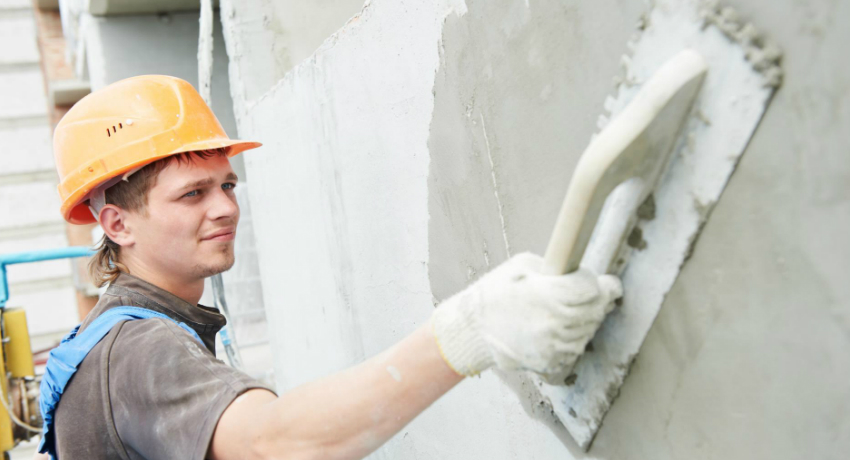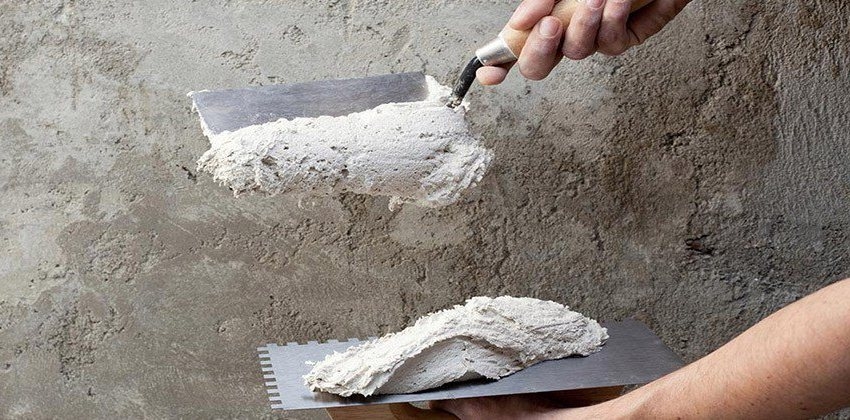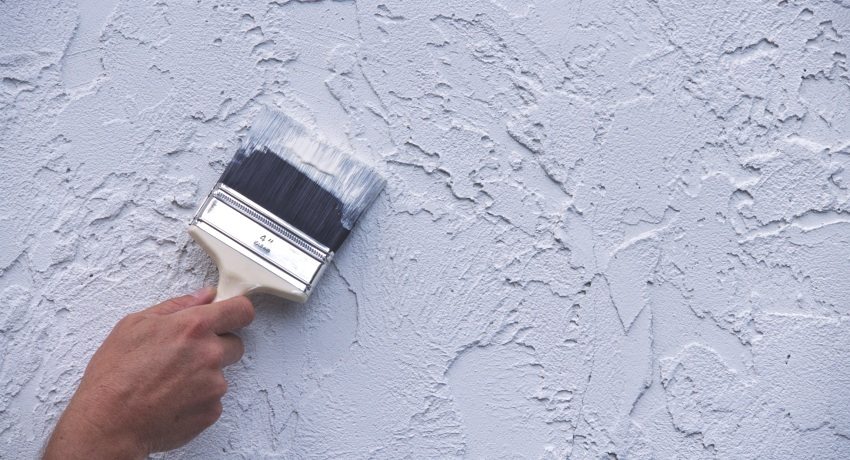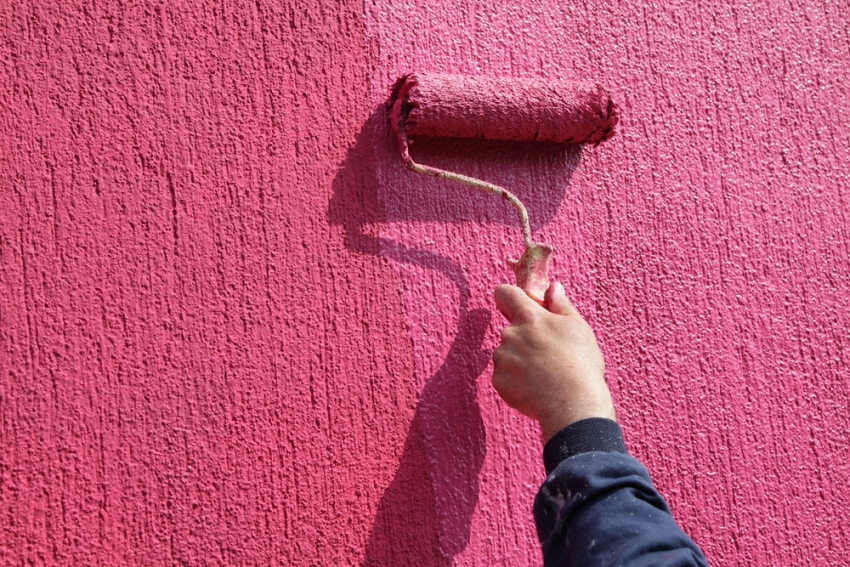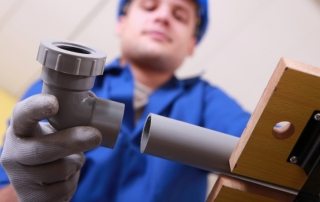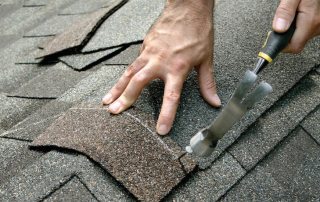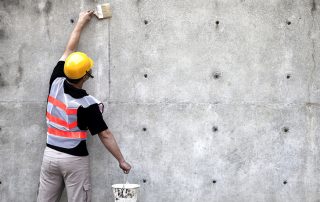After the completion of construction work, they proceed to the external decoration of the walls of the building. High-quality cladding creates not only a presentable appearance of the structure, but also protects the structure from the negative effects of precipitation, sunlight and mechanical damage. Facade plaster for outdoor use is the most demanded material, which can be found in detail in this article.
Content [Hide]
Surface preparation with facade putty for outdoor use
Before moving on to the finishing cladding of the outer walls of the building, you should prepare the base using the facade putty. It is intended for leveling surfaces made of concrete, stone, brick, foam blocks, gas blocks, gypsum boards and other materials. Facade putty for external work must be moisture-resistant, frost-resistant, para-permeable and elastic.
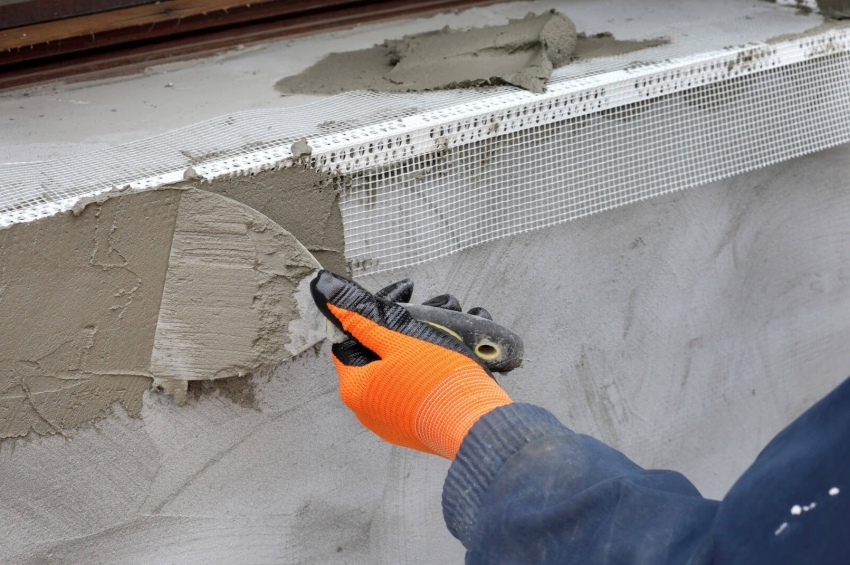
Facade plaster for outdoor use helps to protect the facade of the building from negative atmospheric phenomena
Distinguish between starting and finishing facade putty. The starting mixture is used for the bottom finish of the base. Due to its coarse-grained structure, it is able to smooth out irregularities, drops. Used for patching up chips and cracks. The result is a solid foundation. The working solution should resemble sour cream in consistency. The putty is applied in a layer of no more than 1.5 cm.
The fine textured finishing putty is used for the final leveling of the substrate and provides a smooth, even surface for subsequent decorative cladding. The working solution is prepared more liquid than the starting mixture. The layer thickness should not be more than 4 mm.
Depending on the composition, the putty can be cement or polymer. Cement compositions are highly resistant to moisture and low temperatures. As part of the starting cement mixtures, there is quartz sand, and marble dust or quartz ground sand is added to the finishing putty. This is an unpretentious and inexpensive option, however, cracks may appear on the surface when the building shrinks. Popular brands of cement putties are Kreisel 662, SCANMIX TT, Knauf Multi-Finish, Plitonite and Fasad.
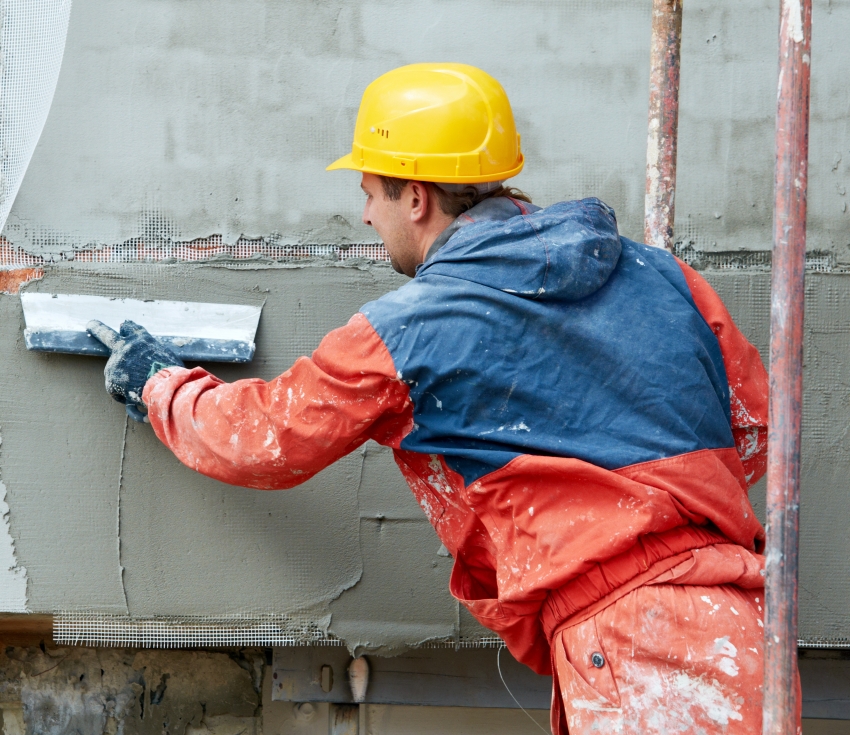
Correctly carried out stages of external plastering allow you to achieve a high level of sound and thermal insulation of the walls
Polymer putties, which include polymer binders, can be acrylic or latex. Acrylic mixtures are moisture resistant, elastic and plastic due to the main component - acrylic. This plaster is applied to a pre-primed concrete or foam concrete surface, in a layer of 1-3 mm.
Latex putty, made on the basis of latex, is produced in the form of a paste without odor and emission of harmful substances. This mixture has high ductility, which excludes the formation of cracks after it dries. Despite the high cost, it creates a durable coating. The most popular brands of polymer putties are SCANMIX LH STANDART, Bolars, Parade Classic.
Now you can proceed directly to the decorative design of the walls of the building using facade plaster for outdoor use.
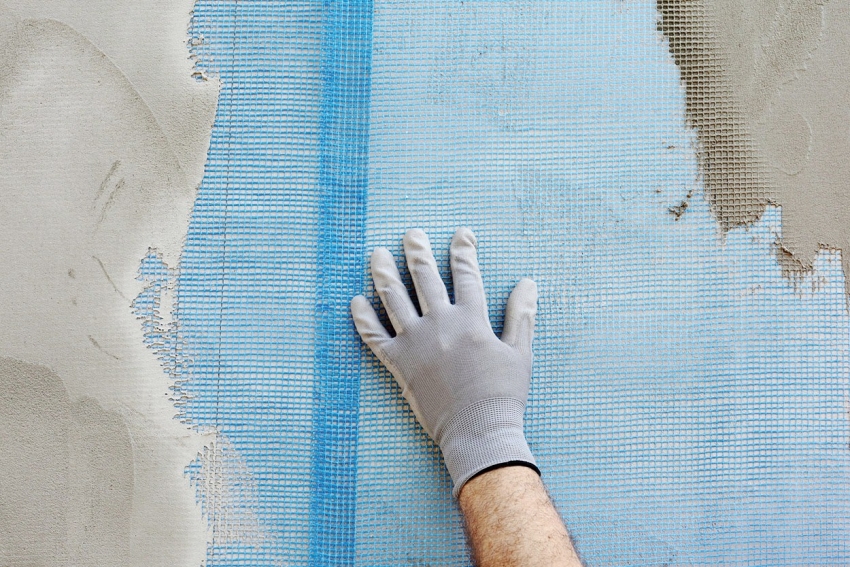
Depending on the type of plastering work, it is recommended to use a reinforcing mesh to improve adhesion
Facade plaster for outdoor use: varieties and famous brands
Decorative plaster for outdoor use is different from cladding materials that are intended for indoor use. The composition of these mixtures contains additives that give the material plasticity, strength, moisture resistance and frost resistance.
Asking the question of how to choose facade plaster for outdoor work, you need to pay attention to the compliance of the material with such requirements:
- resistance to temperature extremes;
- the presence of water-repellent properties;
- increased vapor permeability;
- sufficient strength to ensure the protection of the building facade from mechanical damage;
- the coating should create sound and heat insulation;
- increased resistance to harmful radiation;
- the presence of decorative characteristics of the composition.
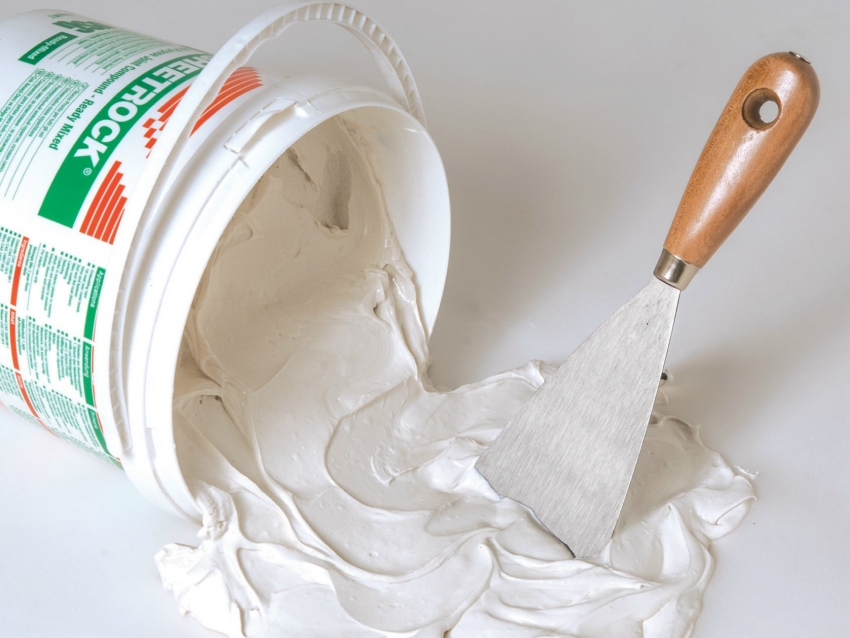
Plaster mixes can be purchased both ready-made and in the form of a powder, which must be diluted by yourself
Any external finish creates additional thermal insulation for the building. However, for thin walls, you should choose the so-called warm plaster for outdoor use, which will contain a special filler. It can be perlite, expanded polystyrene, vermiculite, sawdust or foam glass. They increase the thermal insulation properties of the finishing mixture. So, a 3 cm layer of plaster is able to replace 15 cm thick brickwork in its characteristics.
An additional soundproofing layer is provided with the exterior plaster of the house. For this, pumice must be present in its composition, magnesite or cement with slag or pumice. These porous components are capable of partially absorbing noise.
Useful advice!If the building is exposed to high noise levels, external plaster, as a reliable sound insulator, is ineffective. You should additionally use mineral wool or foam boards. You can also make warm plaster for the facade.
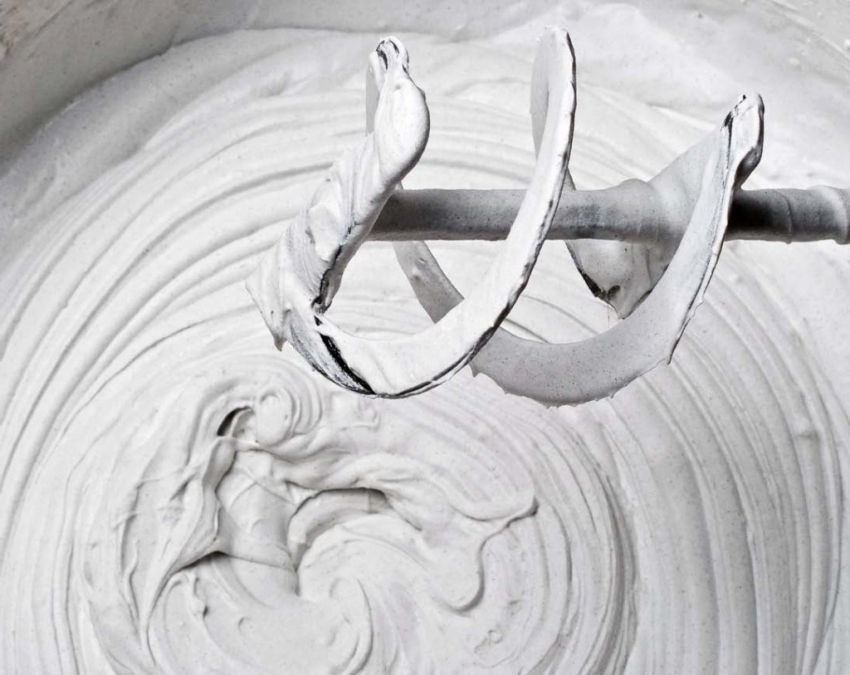
The correct consistency of the plaster will allow you to apply the mixture to the surface with high quality and avoid drips and unevenness
Among the proposed range of compositions for outdoor use, 4 main types of facade plasters can be distinguished, which differ in properties, composition and application technology. There is also a fifth type - gypsum plaster for outdoor use. However, it is highly susceptible to environmental influences, making it impractical for external cladding. It can be used to level the base or to prepare the surface for subsequent decorative cladding.
All facade plasters can form a smooth or embossed surface of the "bark beetle"," Fur coat "or" mosaic ".
Features of mineral plaster for facades
The composition of mineral plaster includes hydrated lime, Portland cement, stone chips, colored clay, additional elements that increase the performance of the finished surface and components responsible for the texture of the finished facade. Additional fillers may be present in the mix to increase resistance to mold and mildew.
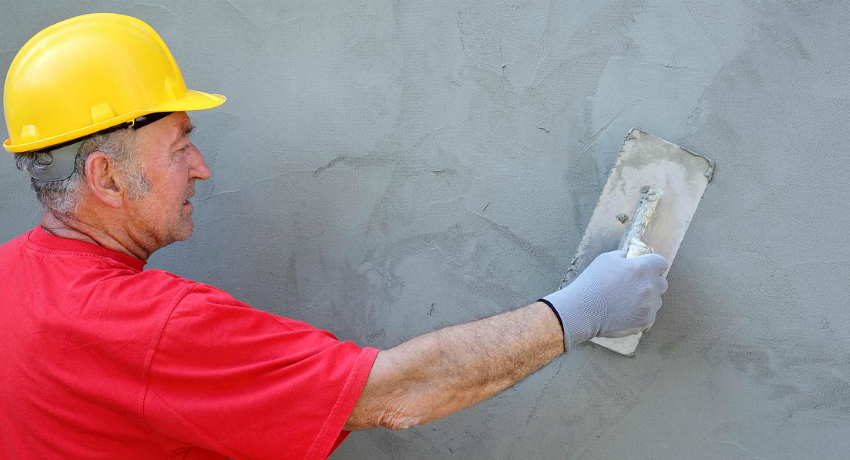
Cement-based facade plaster forms a durable, non-combustible coating with a high level of thermal insulation properties
The mixture is available in ready-made packages in the form of a powder, which must be diluted with a certain amount of water to obtain a ready-made solution. It can be applied to any type of surface. Before facing the walls, it is necessary to mount the mesh under the facade plaster, which will allow to level the surface, create additional adhesion of the plaster to the base and reduce the risk of cracking.
Outdoor cement plaster creates a durable, breathable decorative coating that does not smolder, burn or release toxic substances when heated. The suitability of the composition for work is no more than 90 minutes. After complete drying, a durable non-combustible coating with sound and heat insulating properties forms on the wall surface. The decorativeness of the finishing material is provided by colored additives and granules.
Useful advice! Due to its low vibration resistance, mineral plaster should not be used for buildings located near railways and in areas with high seismic activity.
Mineral plaster is able to withstand temperature fluctuations from -30 to + 45 ° C. without losing their performance properties. The service life of such a coating is at least 15 years.
The color range of cement plaster is very limited, which reduces the degree of its decorative effect. The finished cement plaster surface can be painted in any color, thereby creating a more aesthetic appearance of the building.
Today, Knauf mineral facade plasters from the Diamant line are very popular, which have increased moisture-repellent properties and resistance to aggressive weathering. Using a mixture of Diamant-240, you can obtain a textured surface "bark beetle", And Diamant-260 forms a rough lining, which is called" fur coat ". The price of a 25 kg package is about 900 rubles.
Another equally popular option is Bolars mineral facade plaster, which can be bought at a price of 700 rubles. Having a self-leveling structure, thanks to the modifying additives included in its composition, it creates a perfectly flat and smooth surface.
Acrylic decorative plaster for the facade of the house
In the composition of acrylic plaster, instead of cement, as a binder, acrylic resins are used. In addition, modifiers are used here that increase the ductility and strength of the coating, dyes and one of the fillers, such as stone chips, sand or colored granules, which creates the structure of the decorative surface.
Acrylic plaster is produced in the form of a ready-made solution, which is immediately suitable for application. The layer hardens after 20 minutes, and the surface is completely dry after 48 hours. During this time, the coating should be protected from exposure to direct sunlight, which contribute to cracking of the facing layer.
Useful advice!Due to the quick setting, the joints of the layers can be noticeable on the surface, so it is better to entrust the work to a professional.
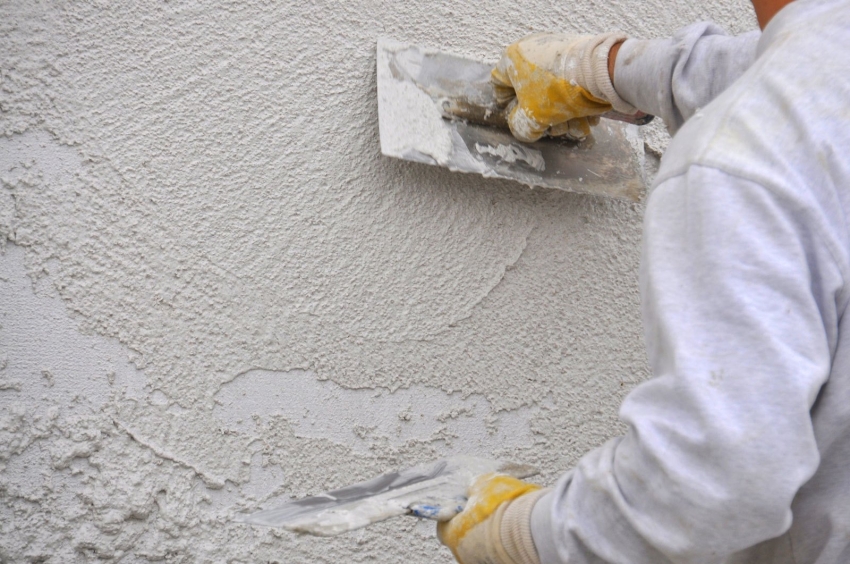
It is worth considering that acrylic plaster for external wall decoration becomes dirty faster, therefore it is recommended to additionally coat it with dyes with water-repellent properties
The acrylic-based mixture is highly resistant to temperature extremes. It creates a good moisture resistant surface with additional protection against strong wind gusts. Due to the high elasticity of the coating, the probability of surface cracking is reduced. The facade of the building, made with acrylic plaster, will have increased resistance to abrasion and impact, which increases the surface life, which reaches 20-25 years.
However, it is able to quickly attract dirt to itself. To clean the surface, it is enough to spray the casing with water from a hose. Another disadvantage of the acrylic-based outer composition is the instability of the pigment to UV radiation, which fades after a while. This plaster is not recommended to be applied to mineral wool base and aerated concrete walls.
Related article:
DIY decorative plaster, video and description
Video of application technology and composition features. Several recipes for self-production of decorative plaster from improvised means.
The most popular manufacturer of acrylic plasters is the Caparol company. The price of the "bark beetle" facade plaster starts from 600 rubles. A mixture of granular structure such as "fur coat" can be purchased at a price of 800 rubles.
An equally popular manufacturer of acrylic mixtures is Baumit, which offers its products at a price of 1500 rubles.
Features of silicone facade plaster
This is one of the most expensive facade mixes. The silicone plaster contains silicone resins, coloring pigments, fillers and additives that increase the durability of the material. The mixture is produced in the form of a ready-made solution, suitable for application on a surface previously cleaned from dirt and dust. The technology for applying the plaster and the conditions for its drying are the same as for the acrylic mixture. Facade cladding works can be carried out in difficult weather conditions. However, the mixture cannot be applied to the insulation layer. On top of it, you need to create a reinforcing mesh.
Useful advice! After finishing the facade cladding with silicone plaster, cover the surface with a silicone primer. This will create additional surface elasticity and leave it intact if the building shrinks.
The silicone coating has increased moisture resistance, elasticity, self-cleaning ability, increased vapor permeability. The material is suitable for cladding not only walls, but also the basement. You should choose silicone facade plaster for aerated concrete, concrete and brick walls. The plastered surface is resistant to salt, therefore it is ideal for coastal regions with high air humidity. The silicone surface will not become a breeding ground for the fungus.
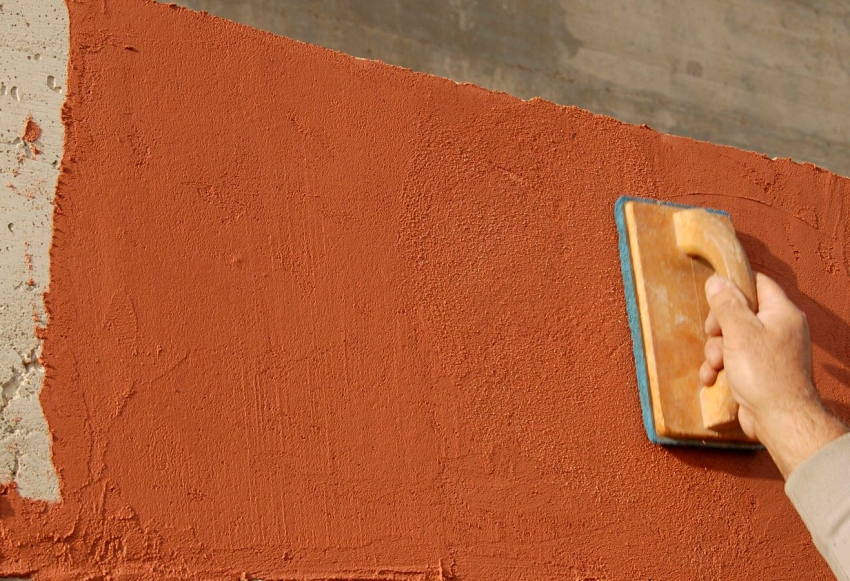
Silicone plaster is an excellent solution for finishing the basement of a building, reliably protecting and extending the operational life of the foundation
There are over 200 options for colors and shades. The pigment, which is part of the mixture, is resistant to UV radiation, does not fade over time. The service life of such a coating is 20-25 years. The only drawback is the high cost of the mixture.
The most popular silicone plasters for the facade, the price of which starts from 2400 rubles, are Caparol decorative mixtures. The manufacturer produces two types of textures for this plaster: "bark beetle" (AmphiSilan Fassadenputz R 20, AmphiSilan Fassadenputz R 20) and "fur coat" (AmphiSilan-Fassadenputz K15, K 20, K30).
Another brand of silicone plasters is the Baumit company, which offers its products from 2300 rubles.
Characteristics of silicate exterior decorative plaster
Another expensive but high-quality facing material is silicate plaster. It is similar in composition to mineral plaster, but is additionally present here liquid potassium glasswhich improves the performance parameters of the surface.
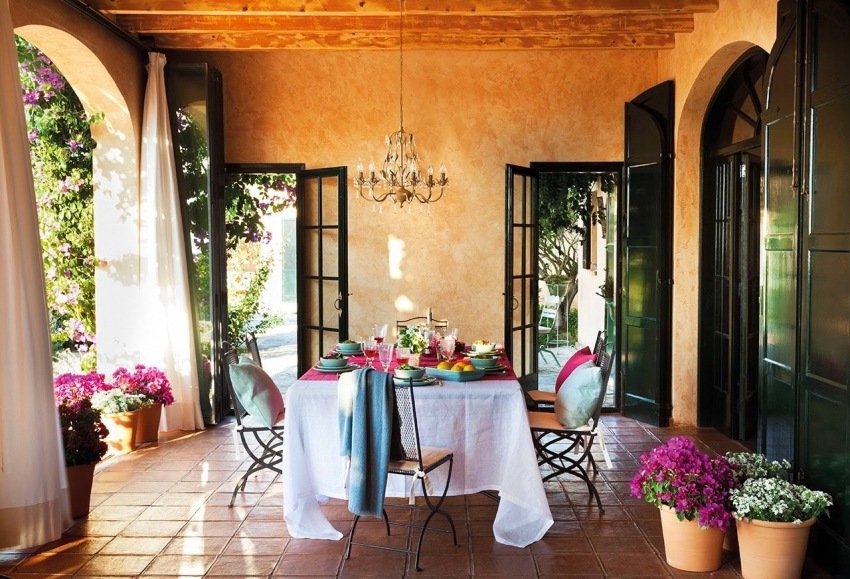
For the decoration of the facade and porch of the house, it is worth choosing plaster, which has not only high performance characteristics, but also decorative properties
It is the most flexible facade plaster. It has high abrasion resistance, moisture resistance, antistatic properties. The cladding surface provides a high level of external wind and moisture protection of the building facade. Preference should be given to silicate facade plaster for aerated concrete, concrete and wooden walls. Such a facing surface is ready to serve for more than 25 years without losing its original decorative and operational properties.
The mixture is sold in the form of a ready-made solution, which is applied to a clean base. Manufacturers have taken care of a wide palette of colors and shades. However, after a while, you can change the color of the surface by painting it with silicate paint.
Important! Silicate plaster should not be applied to polymer insulation and surfaces painted with oil paint or varnish.
The main disadvantage of the silicate mixture is its quick setting after application, which requires perfect work the first time without errors. To do this, you need to use the services of professionals. In addition, before applying silicate plaster, it is necessary to treat the base with a special primer, which increases the adhesion of the mixture.
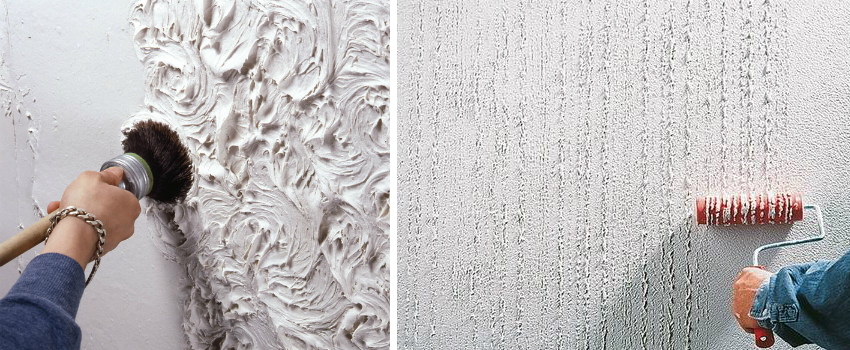
In order to achieve the relief of the decorative plaster layer, it is necessary to use special floats, rollers or brushes.
The most popular manufacturer of silicate decorative facade plaster, the price of which starts from 1800 rubles, is the Baumit company. It offers a wide range of quality and durable products. These mixtures have high viscosity, protect walls from atmospheric precipitation and burnout.
Characteristics and features of Ceresit facade plaster
Today, German-made Ceresit plaster is very popular due to the high quality of the material. Thanks to the special additives included in its composition, high strength characteristics of the material are provided. It is characterized by increased moisture resistance, vapor permeability and elasticity. This coating has a long service life of about 20 years.
There are three types of Ceresit textured facade plaster:
- low-cost polymer-cement mixtures in which cement is used as a binder;
- a mixture with polymer resins, which has high performance;
- expensive polymer-cement plasters, which include cement, sand, polymer synthetic additives, various plasticizers and fibers.
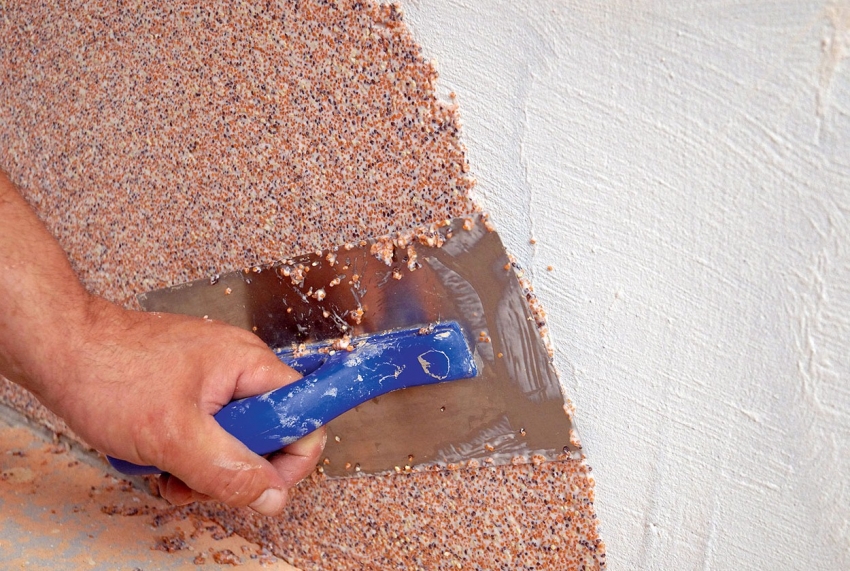
Facade plaster with large marble chips is excellent for cladding the facade of a building, forming a reliable protective layer with excellent decorative characteristics
Ceresit plasters with a polymer composition can be acrylic, silicone and silicate. Acrylic blends are used in areas with high rainfall. Silicone plaster also resists moisture, steam, and snow well. This cladding is strong and durable. Silicate facade plaster adheres firmly to the substrate and is resistant to deformation. She tolerates sunlight well. The cost of cement plaster is about 250 rubles.Decorative textured facade plasters "bark beetle" and "fur coat" can be purchased from 850 rubles.
Thanks to the wide range of colors of Ceresit facade plasters, you can choose the most suitable color that will create an attractive appearance of the building. It should be borne in mind here that very light shades quickly fade and discolor, and too dark shades attract ultraviolet light the most, which contributes to rapid cracking.
Facade wet plaster technology. Price per m2
Wet facade plastering is a technology for finishing the outer walls of a building, in which insulation, reinforced mesh and facing material are attached using semi-liquid or liquid compounds. Thanks to this finish, the dew point that takes over the condensate is carried outside the building, which affects the creation of a favorable microclimate in the house. For wet facade it is typical to use adhesives, including plasters.
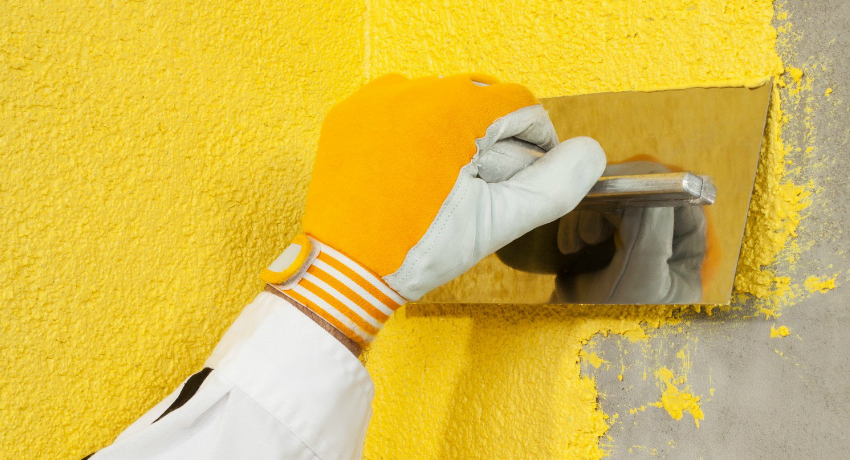
The decorative layer of wet technology for applying facade plaster can be painted with a special color scheme
The wet plaster facade consists of three main layers:
- heat insulating;
- basic;
- decorative.
Insulation of the facade under the plaster is fixed to the base with an adhesive. For this, Portland cement compositions are often used, which provide excellent adhesion of the insulation and the supporting base.
It is very important to choose a good facade insulation for plastering. There are several varieties of this material. The best option in this case is the use of mineral wool, expanded polystyrene or OSB boards. They provide moisture resistance and reliable heat retention. The average cost of installing an insulating layer is 500 rubles / m².
The base layer is a tough layer that protects the insulation from negative influences. Polymer cement mortars or reinforced fiberglass mesh act as an interlayer. Installation of the base layer will cost 150 rubles / sq.
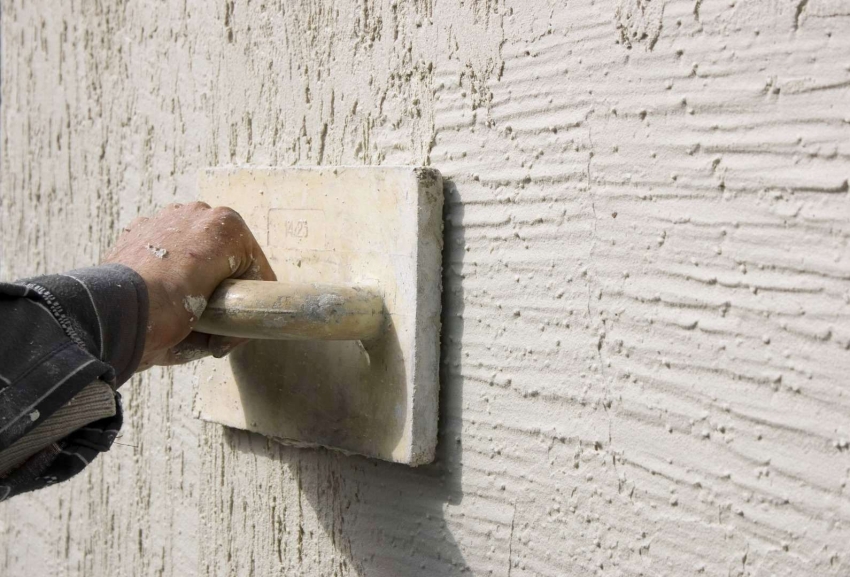
There are several standard schemes for working with textured plaster, for example, "bark beetle" or "fur coat", but if you wish, you can create an absolutely unique, author's drawing or ornament
The creation of a decorative layer is the application of facade plaster to the prepared surface. The cost of plastering walls depends on the method of application (manual or machine) and texture, and on average is 400 rubles / sq. Additional coloring of the facing surface will cost from 170 rubles / sq.
The main purpose of the facade plaster is the final, finishing external decoration of the walls of the building. This decorative coating is affordable, durable and has a number of characteristic features that make it one of the most popular cladding materials.
